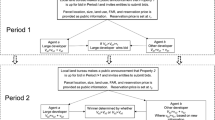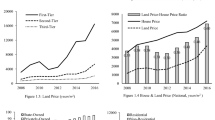Abstract
In this study we incorporate sticky rents into a real options model to rationalize the widely documented overbuilding puzzle in real estate markets. Given the assumption that developers’ objective function is to maximize total revenue by selecting an optimal occupancy level, our model provides a better explanation of the phenomena we observed in the real world than the traditional market-clearance based real options models. We also show that developers’ exercise strategies can be affected by the size and the type of property markets. In other words, developers’ exercise strategies could differ among markets and under different conditions.
Similar content being viewed by others
References
Abreu, D., Dutta, P. K., & Smith, L. (1994). The folk theorem for repeated games: A NEU condition. Econometrica, 62, 939–948.
Aumann, R. J. (1959). Acceptable points in general cooperative n-person games. In R. D. Luce & A. W. Tucker (Eds.), Contributions to the theory of games IV, annals of mathematical study, 40, pp. 287–324. Princeton: Princeton University Press.
Aumann, R. J. (1960). Acceptable points in games of perfect information. Pacific Journal of Mathematics, 10, 381–387.
Aumann, R. J. (1981). Survey of repeated games, in essays in game theory and mathematical economics in honor of Oskar Morgenstern, pp. 11–42. Mannheim/Wein/Zurich: Bibliographisches Institut.
Belsky, E., & Goodman, Jr., J. L. (1996). Explaining the vacancy rate-rent paradox of the 1980s. Journal of Real Estate Research, 11(3), 309–323.
Blackley, D. M., & Follain, J. R. (1996). In search of empirical evidence that links renmt and user cost. Regional Science and Urban Economics, 26, 409–431.
Brennan, M. J., & Schwartz, E. S. (1980). Analyzing convertible bonds. Journal of Financial and Quantitative Analysis, 15(4), 907–929.
Cox, J. C., & Ross, S. A. (1976). The valuation of options for alternative stochastic processes. Journal of Financial Economics, 13, 371–397.
Dixit, A. K., & Pindyck, R. S. (1994). Investment under uncertainty. Princeton University Press: New Jersey.
Fickes, M. (2001). The state of hotel development: it’s on the decline, but that’s good. National Real Estate Investor, 43(5), 118–121.
Friedman, J. (1971). A noncooperative equilibrium for supergames. Review of Economic Studies, 38, 1–12.
Fudenberg, D., & Maskin, E. (1986). The folk theorem in repeated games with discounting and with incomplete information. Econometrica, 54, 533–554.
Gabriel, S. A., & Nofhaft, F. E. (1988). Rental housing markets and the natural vacancy rate. AREUEA Journal, 16(4), 419–429.
Grenadier, S. R. (1995). Valuing lease contracts: A real-option approach. Journal of Financial Economics, 38, 297–331.
Grenadier, S. R. (1996). The strategic exercise of options: Development cascades and overbuilding in real estate. Journal of Finance, 51, 1653–1679.
Harrison, J. M., & Kreps, D. M. (1979). Martingales and arbitrage in multiperiod securities markets. Journal of Economic Theory, 20, 381–408.
Hendershott, P. H. (2000). Property asset bubbles: Evidence from the sydney office market. Journal of Real Estate Finance and Economics, 20(1), 67–81.
Johnson, B. (1998). New development: Where to from here? National Real Estate Investor, 40(5), 18–22.
Jud, G. D., & Frew, J. (1990). Atypicality and the natural vacancy rate hypothesis. AREUEA Journal, 18(3), 294–301.
Kim, I. J., Ramaswamy, K., & Sundaresan, S. (1993). Does default risk in coupons affect the valuation of corporate bonds? A contingent claims model. Financial Management, 22, 117–131.
Kreps, D., Milgrom, P., Roberts, J., & Wilson, R. (1982). Rational cooperation in the finitely repeated prisoners’ dilemma. Journal of Economic Theory, 27, 245–252.
Kummerow, M. (1999). A system dynamics model of cyclical office oversupply. Journal of Real Estate Research, 18(1), 233–255.
Lereah, D. (2004). Economic and commercial real estate market outlook. National Association of Realtors.
Martzoukos, S. H., & Trigeorgis, L. (2002). Real (Investment) options with multiple sources of rare events. European Journal of Operational Research, 136(3), 696–706.
McAneny, D., Han, J., & Gallagher, M. (2001). A cautiously optimistic outlook. Mortgage Banking, 61(5), 4–13.
Merton, R. C. (1973). Theory of rational option pricing. Bell Journal of Economics and Management Science, 4, 141–183.
Merton, R. C. (1975). An asymptotic theory of growth under uncertainty. Review of Economic Studies, 42, 375–393.
Mueller, G. R. (1999). Real estate rental growth rates at different points in the physical market cycle. Journal of Real Estate Research, 18(1), 131–150.
Neyman, A. (1999). Cooperation in repeated games when the number of stages in not commonly known. Econometrica, 67, 45–64.
Øksendal, B. (1998). Stochastic differential equations: An introduction with applications (5th edition). Berlin Heidelberg New York: Springer.
Pagliari Jr., J. L., & Webb, J. R. (1996). On setting apartment rental rates: A regression-based approach. Journal of Real Estate Research, 12(1), 37–61.
Radner, R. (1980). Collusive behavior in non-cooperative Epsilon-Equilibria in oligopolies with long but finite lives. Journal of Economic Theory, 22, 136–154.
Read, C. (1988). Advertising and natural vacancies in rental housing markets. AREUEA Journal, 16(4), 354–363.
Riddiough, T. J. (1997). The economic consequences of regulatory taking risk on land value and development activity. Journal of Urban Economics, 41, 56–77.
Titman, S. (1985). Urban land prices under uncertainty. American Economic Review, 75, 505–514.
Wang, K., & Zhou, Y. (2000). Overbuilding: A game-theoretic approach. Real Estate Economics, 28(3), 493–522.
Wang, K., & Zhou, Y. (2006). Equilibrium real options exercise strategies with multiple players: The case of real estate markets. Real Estate Economics, 34(1), 1–49.
Williams, J. T. (1991). Real estate development as an option. Journal of Real Estate Finance and Economics, 4, 191–208.
Williams, J. T. (1993). Equilibrium and options on real assets. Review of Financial Studies, 6, 825–850.
Author information
Authors and Affiliations
Corresponding author
Additional information
Submitted to Cambridge—Maastricht 2005 Symposium.
Rights and permissions
About this article
Cite this article
Lai, R.N., Wang, K. & Yang, J. Stickiness of Rental Rates and Developers’ Option Exercise Strategies. J Real Estate Finan Econ 34, 159–188 (2007). https://doi.org/10.1007/s11146-007-9004-3
Published:
Issue Date:
DOI: https://doi.org/10.1007/s11146-007-9004-3




